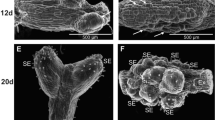Abstract
The use of the synthetic auxin 2,4-dichlorophenoxyacetic acid (2,4-d) has played an important role in the production and maintenance of totipotent cereal callus. However, 2,4-d has been implicated in the loss of totipotency from barley callus. To examine the effect of 2,4-d on barley callus, regenerability and karyotype were examined over time as influenced by cultivar differences and 2,4-d levels, during a period in which initially vigorous plant regeneration typically declines dramatically. Higher (20.4–27.1 μM) versus lower (6.8–13.6 μM) concentrations of 2,4-d were positively associated with the number of green plantlets recovered from calli maintained for 10 and 16 weeks before transfer to regeneration media, and with the longevity of regenerability. There was a positive relationship between 2,4-d concentration and normal karyotype. We also investigated the use of phenylacetic acid for the initiation of regenerable barley callus. Very poor callus growth and plant regeneration was supported by phenylacetic acid.
Similar content being viewed by others
Abbreviations
- PAA:
-
phenylacetic acid
- SPDL(s):
-
single plant-derived lines(s)
- 2,4-d :
-
2,4-dichlorophenoxyacetic acid
- MS:
-
Murashige and Skoog (1962)
- MSO:
-
Murashige and Skoog medium lacking growth regulators
References
Bregitzer P (1992) Plant regeneration and callus type in barley: Effects of genotype and culture medium. Crop Sci. 32: 1108–1112
Golds TJ, Babezinsky J & Koop HU (1993) Regeneration from intact and sectioned immature embryos of barley (Hordeum vulgare L.): the scutelium exhibits an apico-basal gradient of embryogenic capacity. Plant Sci. 90: 211–218
Goldstein CS & Kronstad WE (1986) Tissue culture and plant regeneration from immature embryo explants of barley, Hordeum vulgare. Theor. Appl. Genet. 71: 631–636
Green CE & Phillips RL (1975) Plant regeneration from tissue cultures of maize. Crop Sci. 15: 417–421
Hang A & Bregitzer P (1993) Chromosomal variations in immature embryo-derived calli from six barley cultivars. J. Hered. 84: 105–108
Lührs R & Lörz H (1987) Plant regeneration in vitro from embryogenic cultures of spring- and winter-type barley (Hordeum vulgare L.) varieties. Theor. Appl. Genet. 75: 16–25
Murashige T & Skoog F (1962) A revised medium for rapid growth and bio assays with tobacco tissue cultures. Physiol. Plant. 15: 473–497
SAS/STAT User's Guide (1988) Release 6.03 edition. Cary, NC: SAS Institute, Inc., (1028 p)
Snedecor GW & Cochran WG (1980) Statistical Methods, 7th (Ed.) Iowa State University Press, Ames
Singh RJ (1986) Chromosomal variation in immature embryo derived calluses of barley (Hordeum vulgare L.). Theor. Appl. Genet. 72: 710–716
Wang XH, Lazzeri PA & Lörz H (1992) Chromosomal variation in dividing protoplasts derived from cell suspensions of barley (Hordeum vulgare L.). Theor. Appl. Genet. 85: 181–185
Ziauddin A & Kasha KJ (1990a) Long-term callus cultures of diploid barley (Hordeum vulgare). I. Auxin effects on culture initiation and maintenance. Euphytica 48: 171–176
Ziauddin A & Kasha KJ (1990b) Long-term callus cultures of diploid barley (Hordeum vulgare). II. Effect of auxins on chromosomal status of cultures and regeneration of plants. Euphytica 48: 279–286
Ziauddin A, Marsolais A, Simion E & Kasha KJ (1992) Improved plant regeneration from wheat anther and barley microspore culture using phenylacetic acid (PAA). Plant Cell Rep. 11: (10)489–493
Author information
Authors and Affiliations
Rights and permissions
About this article
Cite this article
Bregitzer, P., Campbell, R.D. & Wu, Y. Plant regeneration from barley callus: Effects of 2,4-dichlorophenoxyacetic acid and phenylacetic acid. Plant Cell Tiss Organ Cult 43, 229–235 (1995). https://doi.org/10.1007/BF00039949
Received:
Accepted:
Issue Date:
DOI: https://doi.org/10.1007/BF00039949




